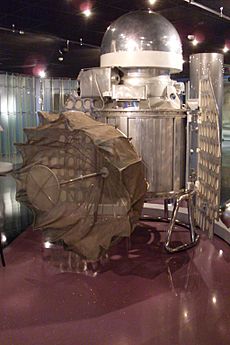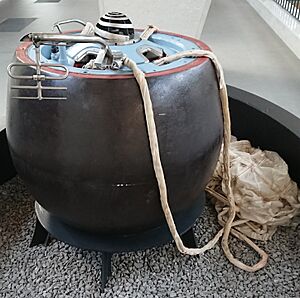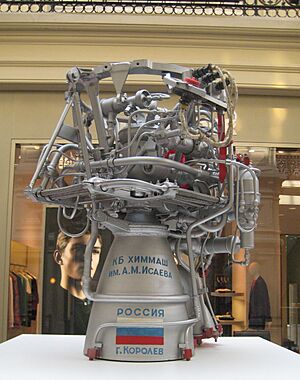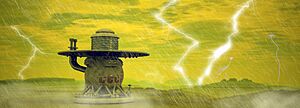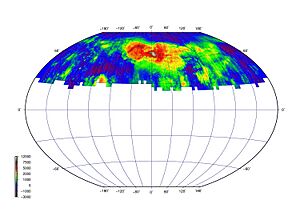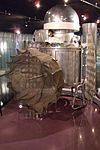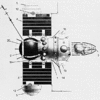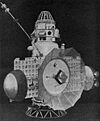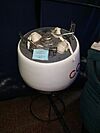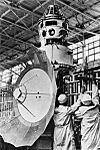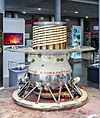Venera facts for kids
The Venera program was a series of space probes built by the Soviet Union between 1961 and 1984. These probes were sent to gather information about the planet Venus. The name "Venera" means 'Venus' in Russian.
Thirteen probes successfully entered the thick Venusian atmosphere. This includes two probes from the later Vega program. Ten of these probes even managed to land safely on the planet's surface. Because of the extreme heat and pressure on Venus, the probes could only survive for a short time, from 23 minutes to two hours.
The Venera program achieved many "firsts" in space exploration:
- Venera 3 was the first human-made object to enter the atmosphere of another planet (March 1, 1966).
- Venera 7 was the first to make a soft landing on another planet (December 15, 1970).
- Venera 9 was the first to send back images from another planet's surface (June 8, 1975).
- Venera 13 was the first to record sounds on another planet (October 30, 1981).
- Venera 15 was the first to create detailed radar maps of another planet (June 2, 1983).
Contents
Exploring Venus: The Venera Probes
Early Missions: Venera 1 and 2
The Soviet Union's first try to send a probe past Venus was on February 4, 1961. However, it failed to leave Earth's orbit. At that time, the Soviets did not announce failed missions. So, this launch was called Tyazhely Sputnik ("Heavy Satellite"). It is also known as Venera 1VA.
Later, the Soviets often launched their planetary probes in pairs. A second probe would be launched soon after the first.
Venera 1 and Venera 2 were designed to fly past Venus without going into orbit around it. Venera 1 launched on February 12, 1961. It lost contact with Earth seven days after launch. Scientists believe it passed within 100,000 km (62,000 mi) of Venus. It is still orbiting the Sun. Venera 2 launched on November 12, 1965. It also lost contact after leaving Earth's orbit.
Several other attempts to send probes past Venus failed in the early 1960s. These were not officially called "Venera" missions at the time.
Atmospheric Probes: Venera 3 to 6
The Venera 3 to 6 probes were quite similar in design. They weighed about one ton (2,200 lb). A Molniya rocket launched them. Each probe had a main "bus" and a round part for entering the atmosphere. These probes were made to study Venus's atmosphere. They did not have special equipment for landing softly. Scientists hoped they would reach the surface still working. However, the first probes failed very quickly, stopping data from being sent to Earth.
Venera 3 became the first human-made object to hit another planet's surface. It crash-landed on March 1, 1966. But the spacecraft's instruments stopped working when it entered Venus's atmosphere. So, no data was sent back from inside the atmosphere.
On October 18, 1967, Venera 4 became the first spacecraft to measure the atmosphere of another planet. This probe showed that the main gas in Venus's atmosphere is carbon dioxide (CO2). The Soviet Union first said the craft reached the surface in one piece. But later studies showed that Venus's surface pressure was much higher than Venera 4 could handle. The probe was crushed before reaching the ground.
Because of this, the Soviets realized their probes would be crushed. So, they launched Venera 5 and Venera 6 as probes mainly for the atmosphere. These crafts were designed to drop nearly half their weight before entering the planet's atmosphere. They recorded data for 53 and 51 minutes, respectively. They slowly floated down by parachute before their batteries died.
Around this time, scientists learned that Venus likely did not have liquid water. However, the designs for the Soviet Venera probes still considered the chance of a water landing as late as 1964.
First Soft Landing: Venera 7
The Venera 7 probe launched in August 1970. It was the first one designed to survive Venus's harsh surface conditions. It was also built to make a soft landing. It was made very strong to ensure it would survive. Because of this, it carried few experiments. A problem with an internal switch also limited the scientific data. It got stuck in the "transmit temperature" setting.
Still, scientists managed to figure out the pressure (90 times Earth's atmosphere) from the temperature data (465 °C or 869 °F). This was the first time measurements were taken directly from Venus's surface. Measurements from Venera 4 to 7 also showed that Venus's atmosphere has very fast winds. These winds can reach speeds of up to 100 meters per second (225 mph). This is called "super rotation" of the atmosphere. Besides pressure and temperature, Venera 7 also measured what the atmosphere was made of.
Venera 7's parachute failed just before landing. It hit the surface at 17 meters per second (38 mph) and fell over. But it survived! The antenna was tilted, making the radio signal very weak. However, it was detected for 23 more minutes before its batteries ran out. So, on December 15, 1970, it became the first human-made probe to send data from the surface of Venus.
Surface Studies: Venera 8
Venera 8, launched in 1972, had more scientific tools to study the surface. These included a gamma-ray spectrometer. The main "bus" of Venera 7 and 8 was similar to earlier designs. The lander sent data during its descent and landed in sunlight. It measured the amount of light but did not have a camera. It sent data for almost an hour.
First Images: Venera 9 to 12
After a failed mission called Kosmos 482, the Venera 9 and 10 probes (1975) and Venera 11 and 12 probes (1978) had a new design. They weighed about five tons (11,000 lb). The powerful Proton rocket launched them. They included a main spacecraft that could orbit Venus. This orbiter had engines to slow down and go into Venus orbit. It also acted as a relay station for the lander's signals.
The lander was attached to the top of the orbiter inside a round heat shield. These probes were made to work on the surface. They had a special round part to protect the electronics from the high pressure and heat for as long as possible. Below this was a "crush ring" to absorb the shock of landing. Above the round part was an antenna and a wide, dish-shaped structure. This dish looked like an antenna but was actually an air brake. They were designed to work on the surface for at least 30 minutes. The tools on board changed for different missions. They included cameras and equipment to study the atmosphere and soil. All four landers had problems with their camera lens caps not coming off.
- The Venera 9 lander worked for at least 53 minutes. It took pictures with one of its two cameras. The other lens cap did not open.
- The Venera 10 lander worked for at least 65 minutes. It also took pictures with one of its two cameras. The other lens cap did not open.
- The Venera 11 lander worked for at least 95 minutes. But neither camera's lens cap opened.
- The Venera 12 lander worked for at least 110 minutes. Again, neither camera's lens cap opened.
Color Images and Soil Samples: Venera 13 and 14
Venera 13 and 14 (launched in 1981–82) each had a landing craft. This craft held most of the instruments and electronics. There was also a flyby spacecraft that helped relay communications. Their design was similar to the earlier Venera 9–12 landers. They carried tools to take scientific measurements of the ground and atmosphere once they landed. These included cameras, a microphone, a drill and soil sampler, and a seismometer (to detect ground movement). They also had tools to record electrical discharges (like lightning) during their descent through Venus's atmosphere.
The two landing crafts landed about 950 km (590 mi) apart. This was just east of an elevated area called Phoebe Regio. The Venera 13 lander survived for 127 minutes. The Venera 14 lander survived for 57 minutes. This was much longer than the planned design life of only 32 minutes. The Venera 14 craft had a bit of bad luck. Its camera lens cap fell directly under the arm that was supposed to test how soft the surface was. So, it ended up testing the lens cap instead of the ground! The landing vehicles sent data to the main spacecraft, which then relayed it back to Earth as they flew past Venus.
Radar Mapping: Venera 15 and 16
The Venera 15 and 16 spacecraft, launched in 1983, were orbiters. This means they stayed in orbit around Venus. They were similar to previous probes. However, their landing probes were replaced with special radar equipment for imaging the surface. Radar imaging was needed to see through Venus's thick clouds. Both missions had identical radar systems.
The radar system was very important for mapping. It worked for 8 months to map Venus's surface with good detail (1 to 2 kilometers or 0.6 to 1.2 miles). When the system switched to altimeter mode, it sent and received signals off the Venusian surface.
The missions created a detailed map of the northern half of Venus (from the North Pole down to 30 degrees North latitude). This covered about 115 million square kilometers (71 million square miles). An altimeter also provided height data with a resolution of 50 meters (164 feet). An instrument from East Germany mapped changes in surface temperature.
VeGa Probes: A Combined Mission
The VeGa probes launched in 1984. These missions went to Venus and then to Halley's Comet. The "VeGa" name comes from "Venera" (Venus) and "Gallei" (Halley) in Russian. These probes used the basic Venera design. They included landers and also atmospheric balloons. These balloons floated in Venus's atmosphere and sent back data for about two days.
Future Exploration: Venera-D
Venera-D is a future mission planned for Venus. It would include a very advanced orbiter and a lander. The best times to launch this mission are in 2026 and 2031. However, as of March 2021, Venera-D is planned to launch no earlier than November 2029. Venera-D might include some parts from NASA. These could be balloons, a small satellite for plasma measurements, or a surface station that could last for 24 hours on the lander.
Amazing Discoveries from Venera
The data from the Venera probes led to many important scientific discoveries. They greatly improved our understanding of Venus. The Venera probes provided direct information about Venus's surface and atmosphere. They also taught us how long electronics can last in Venus's harsh conditions.
- Venera 4 was the first successful probe. It showed that carbon dioxide (CO2) is the main gas in Venus's atmosphere.
- Venera 7 found the temperature and pressure data. It also measured what the atmosphere was made of.
- Venera 8 measured elements like potassium (K), uranium (U), and thorium (Th) on the surface using gamma-ray analysis.
- Venera 9 provided the first images of Venus's surface. It also did more gamma-ray analysis. By sending these first images back to Earth, the Venera missions helped share their achievements with the public.
- Venera 13 provided the first color images and X-ray data of the planet's surface.
- After studying the radar images from Venera 15 and 16, scientists concluded that the ridges and grooves on Venus's surface were caused by tectonic movements. This was found by radar imaging from orbit.
Even with their short lifetimes, each Venera mission added a lot to our knowledge of our sister planet.
Types of Venera Probes
| Model | Type | First Launch |
Last Launch |
Missions (success/ total) |
Launch Vehicle |
Mass | Equipment |
|---|---|---|---|---|---|---|---|
| 1VA | Impact | 4 Feb 1961 | 12 Feb 1961 | 0 / 2 | Molniya | 643.5 kg (1,419 lb) | 5 scientific instruments |
| 2MV-1 | Flyby and atmospheric probe | 25 Aug 1962 | 1 Sep 1962 | 0 / 2 | Molniya | 1,097 kg (2,418 lb) | 11 scientific instruments |
| 2MV-2 | Flyby | 12 Sep 1962 | 12 Sep 1962 | 0 / 1 | Molniya | 890 kg (1,960 lb) | 10 scientific instruments |
| 3MV-1 and 1A |
19 Feb 1964 | 2 Apr 1964 | 0 / 3 | Molniya | 948 kg (2,090 lb) and 800 kg (1,800 lb) (1A) |
10 scientific instruments | |
| 3MV-4 | 12 Nov 1965 | 23 Nov 1965 | 0 / 2 | Molniya-M | 963 kg (2,123 lb) | 11 scientific instruments | |
| 3MV-3 | Atmospheric probe and lander |
16 Nov 1965 | 16 Nov 1965 | 0 / 1 | Molniya-M | 958 kg (2,112 lb) | 10 scientific instruments |
| 1V | 12 Jun 1967 | 17 Jun 1967 | 1 / 2 | Molniya-M | 1,106 kg (2,438 lb) | 8 scientific instruments | |
| 2V | 5 Jan 1969 | 10 Jan 1969 | 2 / 2 | Molniya-M | 1,130 kg (2,490 lb) | 8 scientific instruments | |
| 3V | 17 Aug 1970 | 31 Mar 1972 | 2 / 4 | Molniya-M | 1,180 kg (2,600 lb) | 5 or 9 scientific instruments | |
| 4V-1 and 1M |
Orbiter and lander | 22 Oct 1975 | 4 Nov 1981 | 6 / 6 | Proton-K | 4,363 kg (9,619 lb) 5,033 kg (11,096 lb) |
16 and 21 scientific instruments |
| 4V-2 | Orbiter | 2 Jun 1983 | 7 Jun 1983 | 2 / 2 | Proton-K | 5,250 kg (11,570 lb) 5,300 kg (11,700 lb) |
7 scientific instruments with radar |
Venera Mission Flight Data
| Name | Model | Mission | Launch | Arrival | Survival time min | Results | Image | Lander coordin. |
|---|---|---|---|---|---|---|---|---|
| Venera 1VA No. 1 | 1VA No. 1 | Flyby | 4 February 1961 | N/A | N/A | Failed to leave Earth orbit | N/A | |
| Venera 1 | 1VA No. 2 | Flyby | 12 February 1961 | N/A | N/A | Communications lost on the way to Venus | N/A | |
| Venera 2MV-1 No.1 | 2MV-1 No.1 | Atmospheric probe | 25 August 1962 | N/A | N/A | Escape stage failed; Re-entered Earth's atmosphere three days later | N/A | |
| Venera 2MV-1 No.2 | 2MV-1 No.2 | Atmospheric probe | 1 September 1962 | N/A | N/A | Escape stage failed; Re-entered Earth's atmosphere five days later | N/A | |
| Venera 2MV-2 No.1 | 2MV-2 No.1 | Flyby | 12 September 1962 | N/A | N/A | Third stage exploded; Spacecraft destroyed | N/A | |
| Venera 3MV-1 No.2 | 3MV-1 No.2 | Flyby | 19 February 1964 | N/A | N/A | Did not reach parking orbit | N/A | |
| Kosmos 27 | 3MV-1 No.3 | Flyby | 27 March 1964 | N/A | N/A | Escape stage failed | N/A | |
| Venera 2 | 3MV-4 No.4 | Flyby | 12 November 1965 | N/A | N/A | Communications lost just before arrival | N/A | |
| Venera 3 | 3MV-3 No.1 | Atmospheric probe | 16 November 1965 | N/A | N/A | Communications lost just before atmospheric entry. This was the first human-made object to land on another planet on March 1, 1966 (it crashed). Probable landing region: -20° to 20° N, 60° to 80° E. | N/A | |
| Kosmos 96 | 3MV-4 No.6 | Atmospheric probe | 23 November 1965 | N/A | N/A | Failed to leave Earth orbit and reentered the atmosphere. | N/A | |
| Venera 4 | 4V-1 No.310 | Atmospheric probe | 12 June 1967 | 18 October 1967 | N/A | The first probe to enter another planet's atmosphere and send back data. Although it did not transmit from the surface, this was the first time any probe sent data from another planet. Landed somewhere near latitude 19° N, longitude 38° E. | N/A | |
| Kosmos 167 | 4V-1 No.311 | Atmospheric probe | 17 June 1967 | N/A | N/A | Escape stage failed; Re-entered eight days later | N/A | |
| Venera 5 | 2V (V-69) No. 330 | Atmospheric probe | 5 January 1969 | 16 May 1969 | 53* | Successfully returned atmospheric data before being crushed by pressure within 26 km (16 mi) of the surface. Landed at 3° S, 18° E. | N/A | |
| Venera 6 | 2V (V-69) No.331 | Atmospheric probe | 10 January 1969 | 17 May 1969 | 51* | Successfully returned atmospheric data before being crushed by pressure within 11 km (6.8 mi) of the surface. Landed at 5° S, 23° E. | N/A | |
| Venera 7 | 4V-1 No. 630 | Lander | 17 August 1970 | 15 December 1970 | 23 | The first successful landing of a spacecraft on another planet, and the first transmission from another planet's surface. Survived for 23 minutes before giving in to heat and pressure. | 5°S 351°E / 5°S 351°E | |
| Kosmos 359 | 3V (V-70) | Lander | 22 August 1970 | N/A | N/A | Escape stage failed; Ended up in an elliptical Earth orbit | N/A | N/A |
| Venera 8 | 4V-1 No.670 | Lander | 27 March 1972 | 22 July 1972 | 50 | Landed within a 150 km (93 mi) radius of 10.70° S, 335.25° E. | 10°S 335°E / 10°S 335°E | |
| Kosmos 482 | 3V (V-72) no. 671 | Probe | 31 March 1972 | N/A | N/A | Escape stage exploded during the journey to Venus; Some pieces re-entered Earth's atmosphere and others stayed in Earth orbit | N/A | N/A |
| Venera 9 | 4V-1 No. 660 | Orbiter and Lander | 8 June 1975 | 22 October 1975 | 53 | Sent back the first (black and white) images of Venus' surface. Landed within a 150 km (93 mi) radius of 31.01° N, 291.64° E. | 31°N 291°E / 31°N 291°E | |
| Venera 10 | 4V-1 No. 661 | Orbiter and Lander | 14 June 1975 | 25 October 1975 | 65 | Landed within a 150 km (93 mi) radius of 15.42° N, 291.51° E. | 15°42′N 291°51′E / 15.700°N 291.850°E | |
| Venera 11 | 4V-1 No. 360 | Flyby and Lander | 9 September 1978 | 25 December 1978 | 95 | The lander arrived, but the camera systems failed. | 14°S 299°E / 14°S 299°E | |
| Venera 12 | 4V-1 | Flyby and Lander | 14 September 1978 | 21 December 1978 | 110 | The lander recorded what scientists think was lightning. | 07°S 294°E / 7°S 294°E | |
| Venera 13 | 4V-1 no.760 | Flyby and Lander | 30 October 1981 | 1 March 1982 | 127 | Returned the first color images of Venus' surface. It also found leucite basalt in a soil sample using a spectrometer. | 07°05′S 303°00′E / 7.083°S 303.000°E | |
| Venera 14 | 4V-1 No. 761 | Flyby and Lander | 4 November 1981 | 5 March 1982 | 57 | A soil sample showed tholeiitic basalt (similar to rocks found on Earth's mid-ocean ridges). | 13°25′S 310°00′E / 13.417°S 310.000°E | |
| Venera 15 | 4V-2 No. 860 | Orbiter | 2 June 1983 | 10 October 1983 | N/A | Mapped (along with Venera 16) the northern hemisphere down to 30 degrees from North (resolution 1–2 km). | N/A | |
| Venera 16 | 4V-2 | Orbiter | 7 June 1983 | 14 October 1983 | N/A | Mapped (along with Venera 15) the northern hemisphere down to 30 degrees from North (resolution 1–2 km). | N/A | |
| Vega 1 | 5VK No. 902 | Flyby and Lander | 15 December 1984 | 11 June 1985 | N/A | Part of the Vega program. The spacecraft was on its way to Halley's Comet. During entry into Venus's atmosphere, the surface instruments started working too early, and the lander failed. | 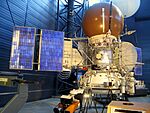 |
07°05′N 177°07′E / 7.083°N 177.117°E |
| Vega 2 | 5VK No. 901 | Flyby and Lander | 21 December 1984 | 15 June 1985 | 56 | Part of the Vega program. The spacecraft was on its way to Halley's Comet. |  |
08°05′S 177°07′E / 8.083°S 177.117°E |
Images for kids
-
Position of Venera landing sites. Red points show sites that sent back images from the surface. Black central dots show sites where surface samples were analyzed. This map is based on data from Pioneer Venus Orbiter and Magellan.
-
First view of Venus' surface or any other planet other than Earth. This is the first clear panoramic image taken by the Venera 9 lander. It was sent back during the lander's 53-minute working life on October 22, 1975. It was supposed to be a 360-degree image, but the second camera's lens cap did not open. So, it is a 180-degree panorama.
See also
 In Spanish: Programa Venera para niños
In Spanish: Programa Venera para niños
- Astron (spacecraft)
- Pioneer Venus project
- Venera-D
- Mariner 10
- Magellan (spacecraft)
- Venus Express


